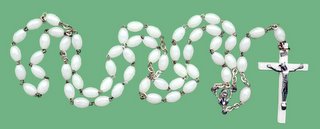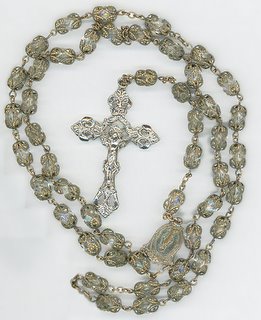Same theme, different beads
New rosaries part 2
As I mentioned earlier, it has been interesting to look at the invention of some "new" rosaries and what they say about rosary history.
I have another, and rather different, example, on the "pro-life" theme. This is a rosary sold by Holy Love Ministries, started by a woman in Ohio who believes she has received visions of Jesus and Mary.
"New" rosaries (sometimes called chaplets) have originated in a variety of ways over time. Many, such as the mid-1800s Rosary for the Dead (invented by Abbé Serre of Nismes, France) or the Chaplet of the Precious Blood (Fr. Francesco Albertini, 1809), were the idea of a particular person. Quite typically the inventors were priests or spiritual directors who developed ideas that they thought would help people in their parishes or under their direction.
Other rosaries, such as the Rosary of Divine Mercy (Saint Faustina Kowalska, 1930s) or the Chaplet of Tears (a Sr. Amalia from Campina, Brazil, 1929), were founded by someone who believed they had a vision.
Visions are a touchy subject. They don't fit into modern society very well, so people who have visions tend to be dismissed as either holy or crazy (or both! ;). At the same time, vision and miracle stories are tremendously popular with the public, which from the Church's point of view doesn't help the situation.
Historically the Catholic Church has been cautious. Catholics are not required to believe in any particular vision, even the ones that have Church approval (although the Church teaches it's wrong to believe visions from God are impossible). Nevertheless, it's quite clear, and well understood by the Church, that not all visions are from God. Some are the products of imagination, wishful thinking, or psychological problems. The Church teaches that Satan can also produce convincing -- but fake -- visions.
Generally, the Church deals with visions according to guidelines laid down in the 18th century by Pope Benedict the Fourteenth (1740-1758). The first investigation of visions is usually the responsibility of the local bishop. If he is convinced a vision is "worthy of belief" he submits a report to the Vatican for approval. As you can see here, most visions are, in fact, not approved, and some are specifically disapproved. In the majority of cases, however, there is simply no decision yet. This "wait and see" period can be quite long.
The pro-life rosary sold by Holy Love Ministries -- called the "Rosary of the Unborn(tm)" -- is another example of a rosary inspired by a vision. Maureen Sweeney-Kyle writes that the Virgin Mary appeared to her, showed her a special rosary, and requested that Holy Love Ministries produce this rosary for the world. She also says that Mary promised that "each 'Hail Mary' prayed on this rosary from a loving heart will rescue one of these innocent lives from death by abortion." (And other promises here)
The beads are an unusual design. The Ave beads (on which one says the "Hail Mary") are transparent blue teardrop shapes. Visible inside each one is a small flesh-colored embryo. The Our Father beads are crosses, each made out of four red teardrop shapes that represent drops of blood. Enthusiasts of this rosary find these beads beautiful and moving. People who don't share this viewpoint can have very different reactions. (Pictures here.)
This example of a "new rosary" comes from a vision on which the Bishop of Cleveland has now issued a statement, saying that the visions are not supernatural in origin. (Thanks to correspondent JH for the update on this.)
And there have certainly been other critics (another here). Some of the contents of the messages Maureen Sweeney-Kyle reports and publishes do seem more than a bit strange.
Another source of unease among those who have commented about this rosary is the very tight hold the ministry maintains on everything related to this rosary. The name "Rosary of the Unborn" is trademarked and its designs are all copyrighted. The rosaries cannot be bought from anyone else -- all sales are direct. (Prices are comparable to more ordinary rosaries.) No one can buy the beads separately to make their own rosary: only finished rosaries are sold. And the ministry says that Mary's promises apply only to these particular rosaries, bought from them.
From a commercial point of view, close protection of a design is not unusual. The designs used are very distinctive, and I suspect that the "teardrop" beads especially were a bit difficult to engineer. Maintaining a monopoly on their product also ensures that any money raised goes only to Holy Love Ministries.
But on a rosary makers' mailing list a year or two ago one person very reasonably (I thought) asked, "... if this rosary can save so many unborn children and help end abortion, then wouldn't Our Lady want as many of them out there as possible?"
This is not the only distinctive rosary resulting from a vision. (In fact I talked about another one here.) These rosaries are created not by Church authorities, but by ordinary lay people. Rosaries have a long history of being a very "grass roots" form of prayer.



